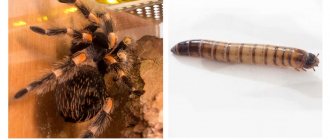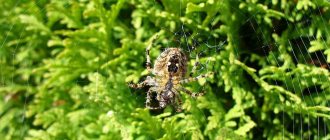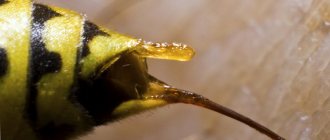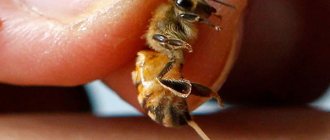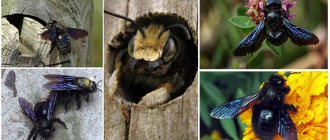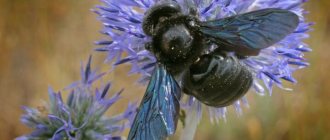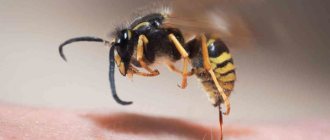Description and characteristics of the honey bee
The body of this insect from the bee family is divided into three parts - the head, chest and abdomen. The abdomen of female bees is divided into 6 joints, and in males - into 7. The animal rests on the exoskeleton surrounding its body - the cuticle, which connects all the body parts into one. The body on top has hairs that help with touch and also protect against dirt from the external environment. The insect's head has an internal skeleton called the tentorium, consisting of dense chitinous beams.
On top of the head there is a pair of antennae, consisting of 11 joints of the same length, and in males (drones) - of 12. Bees have a complex oral apparatus. The mouth in front is covered with a narrow strip of chitin - the upper lip. The lower lip and a pair of mandibles (maxillae) make up the proboscis, which is visible only during suction. At its end there is a small spoon that collects nectar that is inaccessible to the suction tube.
On the sides of the mouth are the upper jaws (mandibles, or mandibles), which also serve as hands. These insects go through a full development cycle, and this type involves passing through four stages - egg, larva, pupa and adult insect. According to scientific classification, insects belong to the Animal Kingdom. So honey bees living in hives are domestic animals, but do not play the same role in human life as, for example, cats and dogs, and are no different from wild ones.
There are 30 breeds of the honey bee species, which differ from each other in color and size, behavior and resistance to different climatic conditions. Typically, varieties of this insect have a gray color or characteristic yellow stripes.
Did you know? The honey bee is native to Asia, where they appeared about 300 million years ago and spread throughout Eurasia and Africa.
They were brought to Australia and the American continent by Europeans.
Internal organization
The body of the animal has a complex structure. The structure of the honey bee resembles in structure the organism of higher animals, which have developed systems and sensory organs. All her movements are driven by fairly powerful muscles.
Digestion
The digestive system consists of three sections. The first includes:
- oral cavity;
- organ of swallowing;
- esophagus;
- goiter for honey.
The middle compartment includes the stomach, the lower part consists of the intestines. Absorption, assimilation, incomplete and complete transformation of nectar into honey are carried out by glands (salivary and subpharyngeal). From the pharynx, food enters the repeatedly expanding esophagus, which forms a crop to accommodate honey, from where the contents are expelled out through the proboscis using muscles. Digestion occurs in the stomach. The intestine is a thin and straight zone. The latter stores undigested food fragments, which the bee gets rid of through the corresponding glands.
Breath
The insect has an impressive respiratory system, including a network of organs. Inhalation occurs through paired stomata on the body: six on the chest and twelve on the abdomen. Having penetrated through the hairs and purified, the air fills special sacs and spreads throughout the body. Exhalation is carried out by the third pair of holes in the thoracic region.
Heartbeat
The heart of the honey bee, consisting of five chambers, looks like an elongated tube stretching along the upper part of the body. However, instead of blood, it is filled with hemolymph (plasma), which passes through the valves in the direction from the abdomen to the head. The uniformity of the current is regulated by the thoracic and dorsal diaphragm. The heart rate of a pacified insect is 100 beats per second, and immediately after flight it increases to 150.
Sense organs
Bees' vision allows them to see completely everything around them and simultaneously above and below. Images from the five eyes are combined into a single mosaic picture. Insects are able to determine the direction of light waves and even in cloudy weather know where the sun is.
With the help of villi on the antennae, consisting of segments and flagella, bees use the sense of touch, which allows them to determine the location in the darkness of the hive. Antennae also serve bees to detect temperature and humidity. Thanks to the endings located in the mouth, insects are able to determine the category of nectar. Bees do not have ears, but they are able to hear: there are special auditory openings on their bodies. The endings responsible for taste sensations are located not only in the pharynx, but also on the proboscis, antennae and even on the paws.
The work of the body and individual organs
Let us consider the features of the functioning of the organs of the honey bee.
Digestive system
Three sections are involved in the digestion of food. The first consists of the pharynx, esophagus and honey goiter. This goiter expands 3–4 times when nectar or honey enters and, using its muscles, can squeeze nectar (honey) out through the proboscis. The main process of digestion occurs in the midgut (second section).
After it, everything goes to the third section (small and large intestine). The large intestine (rectum) has considerable capacity and accumulates undigested food, which is preserved for a long time due to the enzyme catalase, which does not allow it to decompose.
Emptying for the winter stops and occurs for the first time during the first flight in the spring. Bee droppings are not used by humans not only because they are difficult to collect, but also because they may contain infectious agents. Sometimes beekeeping products such as dead bees and propolis are mistakenly called droppings.
Respiratory system
When you inhale, air enters the holes in the cuticle (spiracles) on the chest (3 pairs) and abdomen (6 pairs). They contain hairs that clean the incoming air from small dust particles. From the spiracles the air goes into paired sacs located in the head, chest and abdomen. From these, through the trachea, it reaches all organs of the body.
Organs of movement
Honey bees have two pairs of wings - front (much larger) and rear: they are presented in the form of thin transparent plates with veins. In flight, both pairs of wings form one plane, connecting to each other through 17–28 hooks (hamulus), located in front of the hind wings. When landing, they separate and the bee's wings fold.
Did you know? Honey bees can reach speeds of up to 65 km/h (light) and fly up to 4 km from their place of residence. After the bribe, their speed decreases to 20–30 km/h.
Sense organs
The bee has mosaic vision. The compound eyes of females may include 3–4 thousand ocelli (in the queen) or 4–5 thousand ocelli (in worker bees). In males their number reaches 7–10 thousand. There are 3 pairs of simple eyes on the crown. Honeybees see yellow and blue, but do not notice red. They can see ultraviolet and polarized light, which helps them navigate if the sun is hidden behind clouds.
An interesting fact is also that bees do not have hearing organs in the usual sense, but they hear quite well with their antennae and legs. The antennae also have receptors with which the animal can determine humidity, temperature, and carbon dioxide levels. The antennae are also organs of smell. The sense of touch occurs through hairs located on the surface of the body. Taste buds are located in the pharynx, antennae, and paws.
Venom glands
On the back of the abdomen there are two poisonous glands with a container for poison and a sting 2 mm long and only 0.1 mm thick. The sting is jagged, as a result of which it gets stuck in the skin of the bee stung and leads to the latter’s death. When a bite occurs, 0.3–0.8 mm of bee venom is injected. It is colorless and has a bitter taste and a multicomponent composition.
Important! The lethal dose for an adult is 2 g. This is 500–1000 bee stings.
Life cycle duration and reproduction
Bee colonies are social colonies in which each member does his own job. Different members of a bee family have different life expectancies, depending on several factors.
Uterus
This is the only full-fledged female in the nest, capable of reproduction. Her genitals are superbly developed - the ovaries have about 180–200 oviducts, in which eggs are born. The ovaries have a pair of oviducts, which connect into one, connected by the spermatic canal to the spermatic receptacle. After mating with males (drones), their sperm arrives and is stored in the seminal receptacle for the entire life of the uterus. Mating usually occurs on the 7th–10th day of the uterus’ life.
First, starting from 3–5 days after birth, she makes familiarization flights. Then, choosing a fine day, she makes mating flights with drones and mates with several males. After 2–3 days, she lays eggs measuring 1.5–1.6 mm in honeycomb cells prepared by other bees. During this period, worker bees provide her with intensive nutrition and thereby regulate the laying of eggs.
Drones emerge from unfertilized eggs, and females from fertilized eggs. After 3 days, larvae emerge from the eggs, which are fed by worker bees with milk for the first 3 days, and with a mixture of honey and beebread for the next 3 days. Then the honeycombs with the larvae are sealed, where they spin a cocoon for themselves within a day, having previously emptied themselves in the corner of the cell.
In 12 days, the larva transforms into a full-fledged bee, after which the insect gnaws its way to freedom. In total, 21 days pass from the laying of eggs to the birth of a fully formed individual, but the queens are formed faster - in 16 days. Bees, if necessary, can breed a new queen from any 1- or 2-day-old larva. The uterus has larger dimensions (18–25 mm) and short wings in comparison with the body, as well as a slightly shorter proboscis (3.5 mm).
Important! Queens can lay drone eggs due to old age or damage to the oviduct. This situation leads to the death of the bee colony, so beekeepers get rid of the drone queen.
She is most fertile in the first 2 years of life, and then egg production declines. The queens themselves live on average up to 5 years, but can reach the age of 8 years. Reproduction of the queen can be carried out in two forms - natural (swarming) and artificial, for which different methods are used (layering, division of families and raids on the queen).
Worker bees
The basis of any bee colony is made up of worker bees. In large families there can be up to 20–30 thousand individuals in winter and up to 80 thousand individuals in summer. These are females with underdeveloped reproductive organs. Worker bees take care of the offspring, care for the queen, build, clean and guard the nest, prepare honeycomb cells and seal them, and bring prey.
Young (hive) bees work in the hive, not strong enough to fly for a bribe. Individuals aged 15–18 days who have grown up and gained strength begin to actively collect pollen and nectar, water and glue. Such individuals are called flying. The average life expectancy of a worker bee during the bribe period is 30–40 days.
However, if the life cycle occurs during the cold season, then these periods are extended, since in winter there is less work in the hive. How long a honey bee lives is affected by the intensity of its work. The more it works, the shorter its life cycle. Bees born in the fall or in the absence of brood can live up to 12 months.
Drones
Males exist to inseminate the queen. They are somewhat larger than worker bees, but they lack a sting and a shorter proboscis, which makes them unable to work. Drones are 15–17 mm long and have a body weight of 0.2 g. They develop into adults from an egg in 24 days. Sexual maturity is reached by males no earlier than the 12th day of life. In warm weather, they mate with the uterus, after which they die, leaving part of their genital organs in it.
Did you know? Africanized bee
,
or killer bee, which is highly aggressive, also belongs to honey bees.
It was bred by accident during experiments in Brazil in 1956. Drones circling around the queen to fertilize her distract the attention of birds feeding on bees. Sometimes drones change their family for another, but in the winter they are expelled from any nest and they die. In general, the lifespan of males strongly depends on the presence of a queen in the family and its readiness for mating. Typically their lifespan ranges from 2 weeks to 6 months.
Bee family members
What exactly does a bee family consist of? The main members of the family are many worker bees and the queen. In the summer, you can also see drones here, the appearance of which is due to seasonality. The queen and worker bees are female. However, due to the absence of normally developed genital organs in the latter, only the queen can mate with the drone, and subsequently lay eggs. The egg laying process is suspended (and in some cases completely stopped) due to a lack of food, as well as due to low ambient temperatures.
Nest structure
The basis of the bee nest is made up of double-sided honeycombs 24–25 mm thick with hexagonal cells. A distance of 10–12 mm is left between them for movement.
The honeycombs themselves are polished with propolis and are divided into the following types:
- Bees. In such honeycombs, worker bees are raised and food for them (honey and beebread) is stored. On average, their width is 5.42 mm and their depth is 11–12 mm.
- Drones. The queen lays unfertilized eggs in them to hatch males or store honey. The average width of such a cell is 6.5 mm.
- Queen cells. As a rule, they are built separately from the cells, but adjacent to them.
- Transitional. They have an irregular shape and are located in the transition from bee to drone combs, along the edges of frames or where damage has been patched.
- Honey. They are located at the top of the honeycomb and have an elongated shape with an upward slope of 13° to prevent honey leakage.
The cracks in the nest are sealed with propolis (for small holes) or barrier combs.
Did you know? Russian legislation does not regulate the ownership of the swarm in any way. In ancient Rome, a swarm of bees was the property of the owner as long as he pursued it. If the owner did not do this, then anyone could take the swarming bees.
Habitat
The types of honey bees determine their location: a bee bred by humans lives in a hive, and a wild bee lives in tree hollows in the forest or in the ground, that is, it seeks shelter in places where there is no negative influence of the external environment. In comfortable conditions, honey turns out tastier, and its quantity is much greater.
A honey bee, wild or domestic, having found a comfortable position, begins to build wax honeycombs, which consist of numerous cells. Bees deposit pollen (breadbread) and honey directly here. The structure of the honeycomb itself occurs from top to bottom. Over time, the honeycomb construction expands both in length and width, later merging into a single honeycomb. A normal honeycomb is white in color and 22-25 mm thick. However, they tend to darken if bees or drones have been hatched or continue to hatch in them. A strong family with a moderate load during the spring-summer period can allocate up to two kilograms of wax for construction.
Swarming and distribution in nature
The queen produces a special uterine substance for the bees, which is passed on to them. When there are many residents in the nest, due to the intensive laying of eggs by the queen, there is not enough of it, and the insects become restless. First, they begin to prepare for swarming - they make a cell for a new queen, and the old one begins to be limited in reproduction, they stop building honeycombs, and a complete or incomplete cessation of collecting pollen and nectar occurs.
Then, when the queen cells are sealed, a natural separation occurs when the old queen, accompanied by some of the bees and drones, flies off to build a new nest in a suitable place. First, the queen, along with her escort, is grafted onto a tree branch and can remain there from several hours to several days until scout bees arrive and have found a place for a new nest - a hollow, cave or crevice. Such swarming can be repeated, and the next time the swarm is led by a young queen.
Did you know? To collect 1 kg of honey, worker bees need to visit 19 million flowers. Each bee can collect nectar from 7 thousand flowers per day.
How long does a bee live?
The honeybee, wild or domestic, has a rather short lifespan: in the summer it lasts two to three months. If we are talking about a wintering worker bee, then we should talk about a longer life expectancy - from six months to eight months. The lifespan of a bee generally depends on its “layout” during work.
Worker bees perform most of the functions in the colony and do all types of work except laying eggs. The wide scale of work performed by bees is an understandable fact, because the body of the average bee is naturally predisposed and adapted to perform work:
- they have an excellent sense of smell, thanks to which they find and recognize food;
— the honey bee’s vision is excellent;
- well-developed wings, with the help of which the hive is ventilated;
- devices on legs that they use to collect pollen;
- sting - a means of defense against enemy invasion.
A special feature is the presence of glands in bees that produce milk for feeding the larvae.
Common breeds
Let's look at the characteristics of the most famous European breeds for beekeeping:
- Gray mountain Caucasian. It has a gray-silver color, weak swarming, is not aggressive, but protects the hive well. It has excellent performance and collects a lot of honey even from poor honey plants. It does not have the best resistance to disease and frost; representatives can steal honey.
- Ukrainian steppe. They winter well, are very hardworking and have highly productive queens. They are prone to swarming, moderately aggressive, and do not accept other queens well. They are gray in color, but there are individuals with three yellow stripes.
- Karpatskaya (karpatka).
- Krainskaya (karnika). Peaceful, does not swarm, productive. Tolerates cold and heat well. Painted in gray-silver tones.
- Buckfast. Hybrid based on the Italian bee. The breed is peaceful, productive, resistant to diseases, not prone to swarming, and is characterized by faster development. It has a yellow-brown color.
- Italian. A peaceful and highly productive breed with average agility. She has the most egg-laying uteruses. It is better to breed in a southern climate, since the breed does not winter well.
- Central Russian. It winters well, has good immunity, endurance and performance. Queens are distinguished by high egg production. The breed has a tendency to swarm. This bee prefers to collect nectar from one type of plant, but if necessary, it can collect nectar from other flowers. Does not steal honey, but is aggressive towards the beekeeper. It has a dark gray color and a larger size.
It is distinguished by a peaceful disposition, high efficiency, tolerates winters well and is resistant to diseases. Has no tendency to swarm. Collects enough honey even from poor honey plants and easily switches from one type of plant to another. Has a gray color.
Differences between a wild worker and a domestic one
Since these insects still belong to the same species category, they have a lot in common:
- both domestic and wild bee families live in a close-knit, organized group;
- Each bee in the hive has its own responsibilities. Typically these are worker bees, drones, queen bees and honey bees;
- to store honey they create honeycombs;
- Everyone's main body parts are the same. The differences are only in some small details;
- use the sting for defense.
Here are some differences between a wild specimen and a domestic one:
- A wild representative of the bee family is more aggressive and is capable of attacking a person or animal even at the slightest extra sound, movement or smell that she does not like.
- Undomesticated insects are more industrious and much more active in collecting nectar and making honey. As a result, they stock more for the winter.
- The body of wild honey bees is smaller than that of domestic bees - reaching 2 - 3 cm in length. But there are also major representatives. The largest wild bee spotted in Nepal.
- Some representatives have a “fur” covering and a protective shell on the chest.
- They have better immunity, practically do not get sick and are able to survive even cold temperatures of -50 degrees.
- The color of such workers is gray, the characteristic yellow color is absent. And some varieties don’t even have clear stripes on their bodies.
This is interesting Interesting facts from the life of bees
Maintenance and care
To successfully breed bees to obtain bee products, you need to properly install the hives and provide the insects with proper care.
Hive location
To choose the right place for an apiary, you must adhere to the following rules:
- The place should be quiet and protected from gusts of wind, as well as direct rays of the sun.
- Evidence should be placed with a slope towards the south to ensure sufficient lighting.
- The apiary is located away from large bodies of water, highways, farms, and industrial facilities.
- There should be enough nectar-producing vegetation around the apiary, with different flowering times. If there is no such place, then the evidence will have to be moved to flowering places.
- The apiary and the area around it - for collecting nectar, this is a radius of 2-3 km, must be without persistent foci of diseases.
Did you know? It has been noted that the Central Russian breed of honey bees secretes the most useful substances into honey.
Arrangement
Evidence can be purchased, or you can make it yourself from soft wood. An important point is to coat the bee houses with a special varnish paint, which will protect well from moisture and enable the bee to quickly locate its home. To do this, you need to choose yellow, blue and green colors.
To maintain the apiary, you must purchase the following tools:
- workwear;
- face mesh;
- smoker;
- foundation, which is inserted into the frame - without it you will get a lot of defective cells;
- special knife;
- caps and cells;
- spur;
- chisel;
- feeders and sugar for syrup (needed for feeding);
- roevnya - a box for catching bees;
- ice rink.
Care depending on the time of year
Caring for bees and apiaries largely depends on seasonality:
- In the spring. As soon as it becomes warm outside (+8°C), the evidence is transferred to fresh air and families are transplanted with intact frames into new houses. At the same time, a printout of the honey frame is made. The evidence must contain at least 8 kg of honey. Old hives are repaired, cleaned and disinfected. If the apiary is located in a place where bribes are not observed in the spring, then after 30 days it is necessary to add beebread and honey. Care should be taken to insulate the evidence (seal the joints, cover).
- In summer. They control the swarming process and take only the first swarm from the hive, collecting it using a swarmer and a scoop. Individuals who have not expressed a desire to move to the swarm are driven there with smoke, blowing it in the desired direction. If necessary, excess queens are removed from the swarm or replanted if she could not be caught. Filled stores are cleaned and put back so that the bees drain the frames. The shops should be removed at the end of August.
- In autumn. On the eve of wintering, it is necessary to check the quality and quantity of honey for the presence of honeydew. To do this, they take samples and conduct laboratory tests or try to determine it themselves. If honeydew is available, honey is removed from the combs and stored for use as feed in the spring. In place of the frame, put a frame with good honey or dry food. You can use sugar syrup as a top dressing. In the fall, old queens should be replaced with new ones. They make nests for the winter - on honey, partly on honey or on sugar syrup enriched with vitamins. They insulate the evidence, treat it against varroa and prepare it for wintering.
- In winter. Keep the temperature in the wintering place not lower than 0°С…+4°С. If it is higher, then you need to increase the ventilation of the room. The optimal humidity in it should be 80%, and it itself should always be dark. It is necessary to provide wintering bees with peace, absence of rodents, and clean the entrances once every 30 days with wire. Periodically inspect the deadwood for the presence of diseases and pests.
Important! You definitely need to pay attention to the noise in the houses - when everything is normal, then the noise is muffled, but if it is increased, then this indicates dryness in the room or crystallization of honey. The absence of sounds signals the lack of food and starvation of insects.
Dangerous wild bees
Insects living in natural conditions, not tamed by humans, can be very dangerous. They are used to protecting their family and their home from any enemy. Wild bees are more aggressive and can become dangerous to humans. If wild bees have settled near your house or on your summer cottage, you should be careful, as this is a rather unpleasant neighborhood.
This is interesting: Preparing sugar syrup to feed bees in the fall
Firstly, the noise made by a large number of bees will disturb you.
Secondly, the danger from their bites is many times greater than from domestic insects. Even a person who is not allergic to them can become ill from the sting of one bee. If a person is bitten by several wild bees at once, this can end very sadly. Their poison is much more concentrated than that of pets, and therefore many times more dangerous.
If you are stung by a wild bee, you should call an ambulance or do the following:
- Remove the sting.
- Treat the wound with alcohol.
- In order to remove the poison, the wound must be thoroughly rinsed with salt water.
- After all procedures, apply a cold compress or a piece of ice.
- Drink plenty of fluids that contain ascorbic acid. It could be tea with lemon or rosehip.
Video: honey from wild bees.
What are the benefits of honey bees?
First of all, these insects produce honey, which is used for consumption in food, medicine, and cosmetology. When keeping bees, they also obtain bee bread, royal jelly, propolis, wax, and bee venom. All bee products are natural antibiotics used for medical purposes. A very important point is the fact that bees actively participate in the pollination of entomophilous plants, which is necessary to obtain a good harvest and seeds.
Benefits of Honey Bees
The main importance of honey bees for humans is in their production of:
- honey;
- wax;
- propolis;
- pollen;
- royal jelly.
These products are used in medicine, cosmetics industry, and food production.
In addition, bees are one of the best pollinators among insects. If the hives are located near fields with buckwheat, sunflowers or orchards, the yield can increase several times.
An apiary located near commercial crops is a guarantee of high yields
Productivity increases - human well-being increases, the green cover of the planet grows, the diversity of plant species does not decrease. Plants enrich the air with oxygen and purify the air - that is, bees make a significant contribution to the ecological stability of the Earth.
Diseases and their prevention
Let's look at common diseases of honey bees:
- American Foulbrood - this infectious disease kills larvae in cells sealed by bees. The larvae rot, forming a dark mass that smells like glue.
- Ascospherosis (lime brood) - a fungal disease that destroys larvae. After death, they become like solid white formations. If larvae in sealed cells are affected, whitish mold appears.
- European Foulbrood - affects larvae. The symptoms are the same as with American foulbrood.
- Israeli acute paralysis virus (IAPV) causes a sharp decrease in immune function, against which many other infections occur. May cause colony destruction.
- Sacbrood is a quarantine infection that primarily affects brood. After death, the larvae turn into a shell filled with granular liquid, and then, when dry, into crusts.
- Acarapidosis. The disease is caused by a tick - this parasite infects the spiracles where it lays eggs, so the second name for acarapidosis is tracheal mite.
- Braulez. The disease is caused by a bee louse (or wingless brawl fly). It affects adults. The presence of such parasites leads to exhaustion of bees, which significantly reduces egg laying and insect productivity.
- Varroatosis. The most common disease in honey bees is caused by Varroa mites. This parasite infects adults, as well as larvae and pupae. Its activity leads to a general weakening of bees and a decrease in immunity. Ticks also carry some contagious diseases.
- Nosema. The disease appears only in adult bees. This disease is caused by the parasite Nosema apis. Nosema usually occurs in late winter or early spring and manifests itself in the form of diarrhea in insects, which heavily contaminates honeycombs and evidence.
- Cold. Occurs due to hypothermia of the nest, which leads to the death of the brood.
- Starvation. Due to lack of food, bees become exhausted, and this can cause death. Fasting can be carbohydrate (lack of honey) and protein (lack of bee bread).
- Chemical toxicosis is caused by pesticides that are used to control insect pests in order to protect plantings. Toxic elements enter the bees along with their food.
- Honeydew toxicosis. Occurs due to poisoning - ingestion of honeydew honey.
- Pollen toxicosis - mainly affects worker bees due to poisoning with nectar from poisonous plant crops.
Find out in more detail how to properly treat bees with Bipin.
To prevent the occurrence of all these troubles, experienced beekeepers recommend the following prevention:
- hives must be well insulated and ventilated;
- periodically inspect, tune and replace nesting cells;
- be sure to disinfect honeycombs, equipment and buildings in the apiary;
- after the bribe, carry out the growth of young bees in order to improve the colony;
- when expanding families, it is necessary to carry out additional insulation;
- It is important to provide bees with good quality food in the required quantities;
- carry out centralized pumping of honey, as well as melting of wax;
- arrange the wintering area well;
- When purchasing, it is better to choose frost-resistant bee species;
- choose strong families of bees, exclude closely related relationships that reduce the vitality of insects;
- assess the nectar collection site for the presence of poisonous vegetation. If such plants are identified, take measures to destroy them;
- during the cold season, be sure to include bee bread in your food;
- inspect bees for timely diagnosis of the onset of the disease - this will help to take the necessary measures in a timely manner;
- do sanitation to eliminate odors, destroy insect pests, pathogens and carriers of diseases, and rodents.
Honey bees living in a hive are classified as domestic animals, but are essentially no different from their wild relatives. However, this does not mean that they do not need to be looked after - in order to preserve families and increase the yield of honey, they simply need care.
